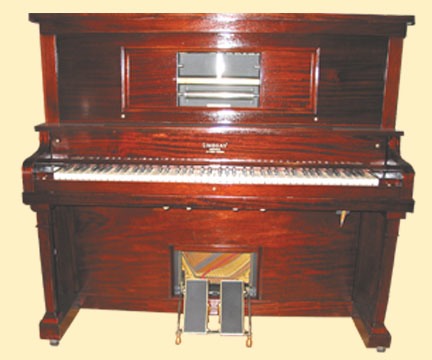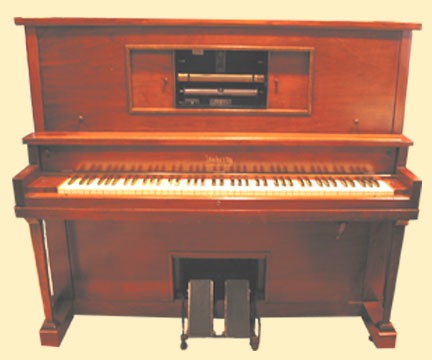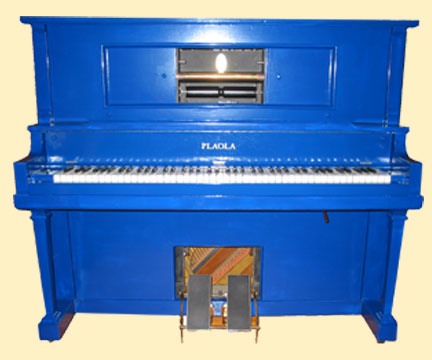THE PLAYER PIANO
Time was in North America when a home was not complete without its player piano. From the beginning of the twentieth century to the end of the ‘Roaring Twenties,’ the player piano reigned as the supreme medium of home entertainment. The old folks could pedal away at ‘Annie Laurie’ and ‘Silver Threads Among the Gold’ to their hearts’ content - after the youngsters had their turn at the ‘William Tell Overture’ and ‘Paderewski’s Minuet.’ Entertainment of any variety was treasured during World War I. The player piano provided an easy means to fill the air with such tunes. Expensive reproducing pianos were capable of exact re-enactment of the performance of great artists.
The first roll-operated piano is believed to have been conceived by Claude-Felix Seytre of Lyons, France in 1842. He used a music sheet made of stiff cardboard. Later, in 1848, Alexander Bain patented a piano that used a perforated roll of normal thickness. The pneumatic player piano mechanism. played by perforated paper music rolls and powered by suction, debuted as a “push up” external piano playing device. They played upon the piano and were considered to be a separate device to be used with the piano.
The “player piano” term came when the so-called “inner player,” the piano which incorporated pneumatic devices within the piano case, was developed. By 1910 the old-style piano player was obsolete. Approximately two million player pianos were manufactured in North America from the early 1900’s to 1930.
Operating Principles
For every note in the piano there is a small pneumatic or bellows which comes in contact with the piano action, the mechanism that connects with the keys and the felt hammers. Each small bellows plays a certain note and through the medium of a wind chest is connected by a rubber tube to larger bellows and by individual rubber tubes to a corresponding note in the tracker or music bar over which the music roll passes when the piano is being played. The large bellows, connected to foot pedals, suck air out of the striking pneumatics so they will collapse when a hole in the music roll comes over a hole in the tracker bar. The outside air rushes in and causes the striking pneumatic to collapse. When the music roll paper covers the hole in the tracker bar, the striking pneumatic returns to its normal position, ready to strike again.
Varieties of Player Pianos
In addition to an ordinary foot-pumped player piano there are also reproducing pianos, coin pianos and orchestrions all of which operate on the same pneumatic principle. Reproducing pianos have sophisticated expression mechanisms in addition to the regular player actions, enabling them to reproduce the playing of human pianists by means of special music rolls. Coin pianos have motor-driven pumping bellows, large multi-tune music rolls, and automatic mechanisms for starting when a coin is deposited, shutting off at the end of each tune, and rewinding after the last tune on the roll. Orchestrions incorporate several extra instruments - xylophones, orchestra bells, organ pipes, drums, etc. - in addition to the piano. The word “nickelodeon” frequently is used as a nickname for coin pianos and orchestrions, but it correctly refers to early-day movie theatres.
By-Gone Days
During the infancy of the phonograph the player piano provided hours of enjoyment for the whole family. With advances in technology this changed. Modern high-fidelity electronic equipment, television, and computers have relegated the player piano to the distant past. Few of these marvelous instruments survive to this day, fewer still have been restored, enabling music of the past to be played from a roll of paper. Some player pianos, however, still fill the home with ‘Poet and Peasant’ or ‘Goodbye Yellow Brick Road.’

1918 "Lindsay" Player Piano S/N 30947
This piano was manufactured by "Lesage Pianos Ltd." (Montreal, Ottawa, Quebec). After selling one of his farms Damase Lesage bought the Canadian Piano Company and built up a company lasting almost 100 years. Its name changed to Lesage Pianos Ltd. in 1942. In 1986 the sweet tones from Lesage had reached the last bar. In October 2001 I purchased this piano at auction. An estate from Ajax, Ontario was selling the piano in Lindsay possibly hoping to get a higher price because of the name. The piano required extensive repair and refinishing. Inside the piano the date September 13, 1918 was written.

1926 "Doherty" Player Piano S/N 95895
William Doherty came to Clinton, Ontario in 1868 and by 1874 had established a furniture and music store and had become a distributor for Bell organs by 1874. Doherty decided that these instruments were not so complicated that he couldn't make them himself. By 1900 Doherty had 180 employees on his payroll. The first pianos appear not to have been manufactured until 1905 or 1906, but within a few short years the company was known as Doherty Piano and Organ Co. Ltd. Two former Doherty employees started an organ company in London (Ontario) and after William Doherty had retired they bought the Doherty business. The Doherty piano name did not remain in use after about 1937. I bought this piano in October 1999.

1926 "Plaola" Player Piano S/N 64487
R.S.Williams started in Hamilton and later acquired the Canada Organ and Piano Company in Oshawa in 1888. Williams established retail outlets in Calgary, Winnipeg, London, and Montreal by 1903. He died on February 1906. His son Robert expanded the business internationally. By 1920 a popular player piano had been developed. Plaola was the name on the player piano line.
In May 2001 I purchased this piano and restored it. Previous history is unknown, however, the piano appears to have been subjected to a fair amount of abuse. I had no choice but to paint the piano because in the past it had about four different types and colours of paint on it and not all in the same place!